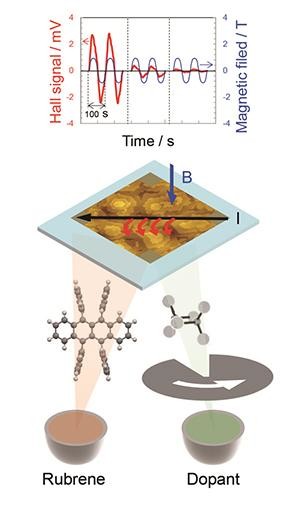Organic single-crystal electronics on the way

Researchers at Japan’s National Institutes of Natural Sciences have succeeded in developing a method for high-performance doping of an organic single crystal, as well as Hall effect measurement of the crystal. Their study has been published in the journal Advanced Materials.
Controlling the ‘holes’ and ‘electrons’ responsible for electric conduction of p-type and n-type semiconductors by doping — adding a trace amount of impurity — had been central in 20th-century inorganic single-crystal electronics such as silicon chips, solar cells and LEDs. The number of carriers (holes and electrons) created by doping and their moving speed (mobility) can be freely evaluated by Hall effect measurement using a magnetic field.
However, in the emerging field of organic electronics, no-one has ever attempted to dope impurities into an organic single crystal itself, nor to measure its Hall effect — until now, that is.
“We have combined the rubrene organic single-crystal growth technique with our original ultraslow deposition technique of one billionth of a nanometre (10-9 nm) per second, which includes a rotating shutter having aperture,” said Chika Ohashi, a PhD student at the Institute for Molecular Science. “For the first time, we have succeeded in producing the 1 ppm doped organic single crystal and have detected its Hall effect signal.”
The doping efficiency of the organic single crystal was 24%, which is a much higher performance compared to 1% for the vacuum deposited amorphous film of the same material.
Lab head Professor Masahiro Hiramoto said the results could lead to the dawn of organic single-crystal electronics, similar to silicon single-crystal electronics. In the future, he said, devices such as high-performance organic single crystal solar cells may be developed.
Organic transistor 'limitation' improves stability
Researchers have shown that a longstanding organic transistor design limitation actually improves...
OLED circular polarisation is now electrically switchable
Researchers have discovered a way to control left- or right-handed polarised light via charge...
Nanoscale pixels to advance augmented reality eyewear
Physicists have developed extremely small pixels that can be used in compact AR glasses, using...





